Key commodities and our preferred exposures
In our most recent Asset Allocation Insights update (Quality Time June 9, 2021), we retained a positive stance on commodities but also expected more modest gains from here. Generally, the reopening of Developed Markets has triggered a surge in demand across commodities. This has been met with supply chain disruptions, resulting in a rise in commodity prices so far in 2021. This is consistent with Morgan Stanley’s expectation regarding higher inflation due to the substantial monetary and fiscal stimulus that is driving both household spending and corporate investment.
Broadly we expect recovering supply conditions to meet normalising demand, bringing some moderation back into commodity prices across most markets in 2022. Until then, micro factors are keenly in focus.
In our review, we focus on several key commodities relevant to Australian investors. For investors seeking a broad exposure to commodities we highlight the Invesco Commodity Composite UCITS ETF (LSE: LGCU) which is on our Focus List and is included in the Global Core+ series model portfolios. Alternatively, if investors are looking for ASX listed stocks we outline Morgan Stanley’s preferred mining exposures by selected commodities.
Exhibit 1 – LGCU is on our Focus List (US$)
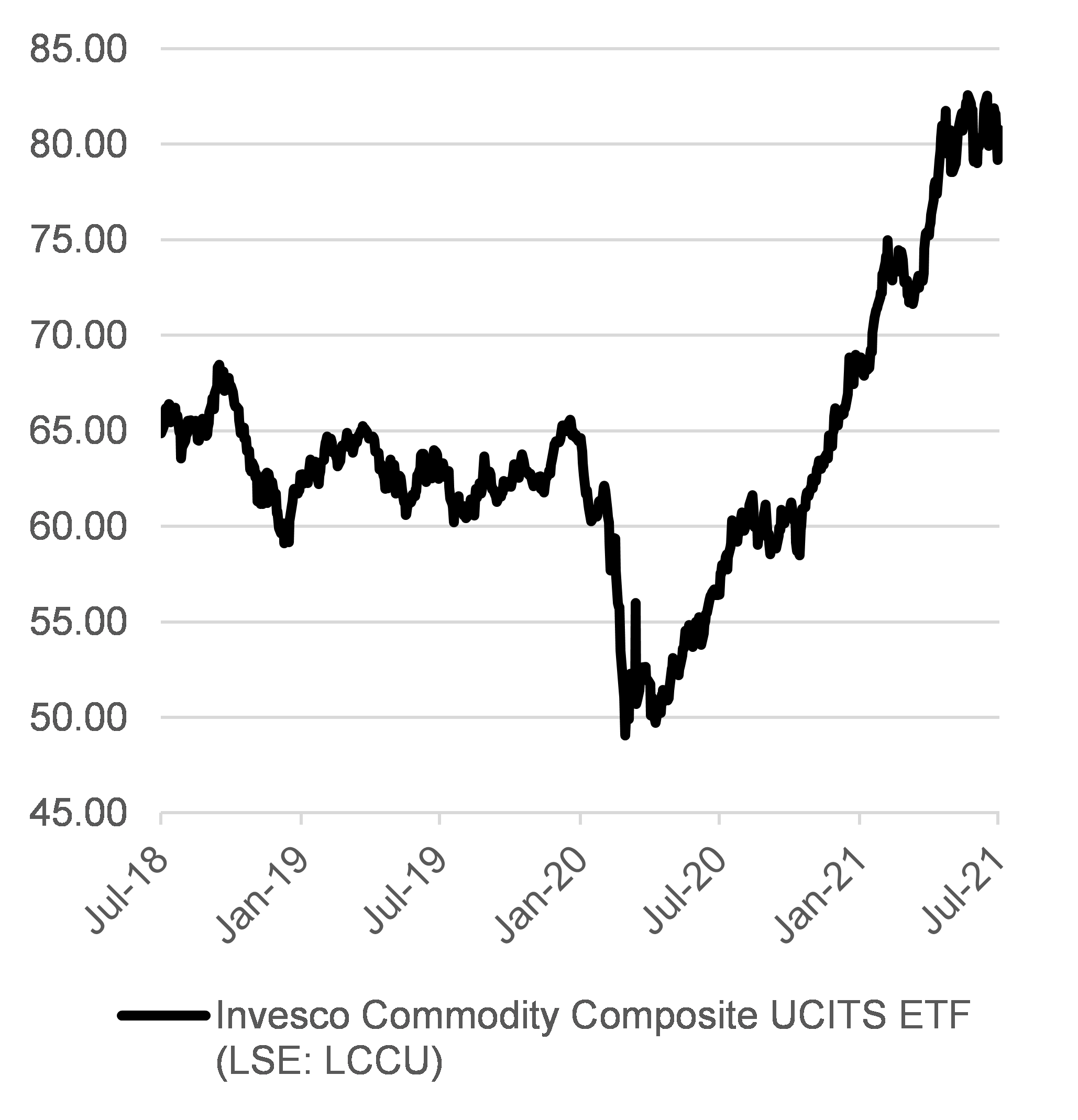
Source: Bloomberg, Morgan Stanley Wealth Management Research. Data as at 21 July 2021.
We acknowledge the insights from Morgan Stanley analysts across multiple disciplines whose extensive work contributed to this review: Susan Bates, Rahul Anand, Marius van Straaten, Christopher Nicholson, Brian Morgan, Dan Shaw, Loannis Masvoulas, Alain Gabriel, Javier Martinex de Olcoz Cerdan, Roberto Browne, Daniela Santoro, Vincent Andrews, Rachel Zhang, Sandeep Peety, Shannon Sinha and Alexander Barkley.
Iron Ore
Despite the Chinese government’s policy target to keep steel output relatively flat in 2021 versus 2020, output continues to climb, with production now up 13% YoY for the first five months to May 2021. Notably, not all the growth in steel production came from conventional blast furnace production. Instead, increased Electric Arc Furnace (EAF) utilisation filled some of the production growth. EAF is the recycling of steel instead of the producing of new virgin steel. Nevertheless, Morgan Stanley still expects China’s steel output to slow in the back half of 2021 as producers face continued policy resistance. Concurrently, we continue to expect iron ore supply to continue to creep higher, led by Vale. Taken together, we retain our bearish stance on iron ore more so because of expected policy headwinds on steel production for the balance of 2021. Morgan Stanley forecasts iron ore at US$160/t by 4Q21 and averaging US$118/t in 2022.
Exhibit 2 – Iron Ore Price
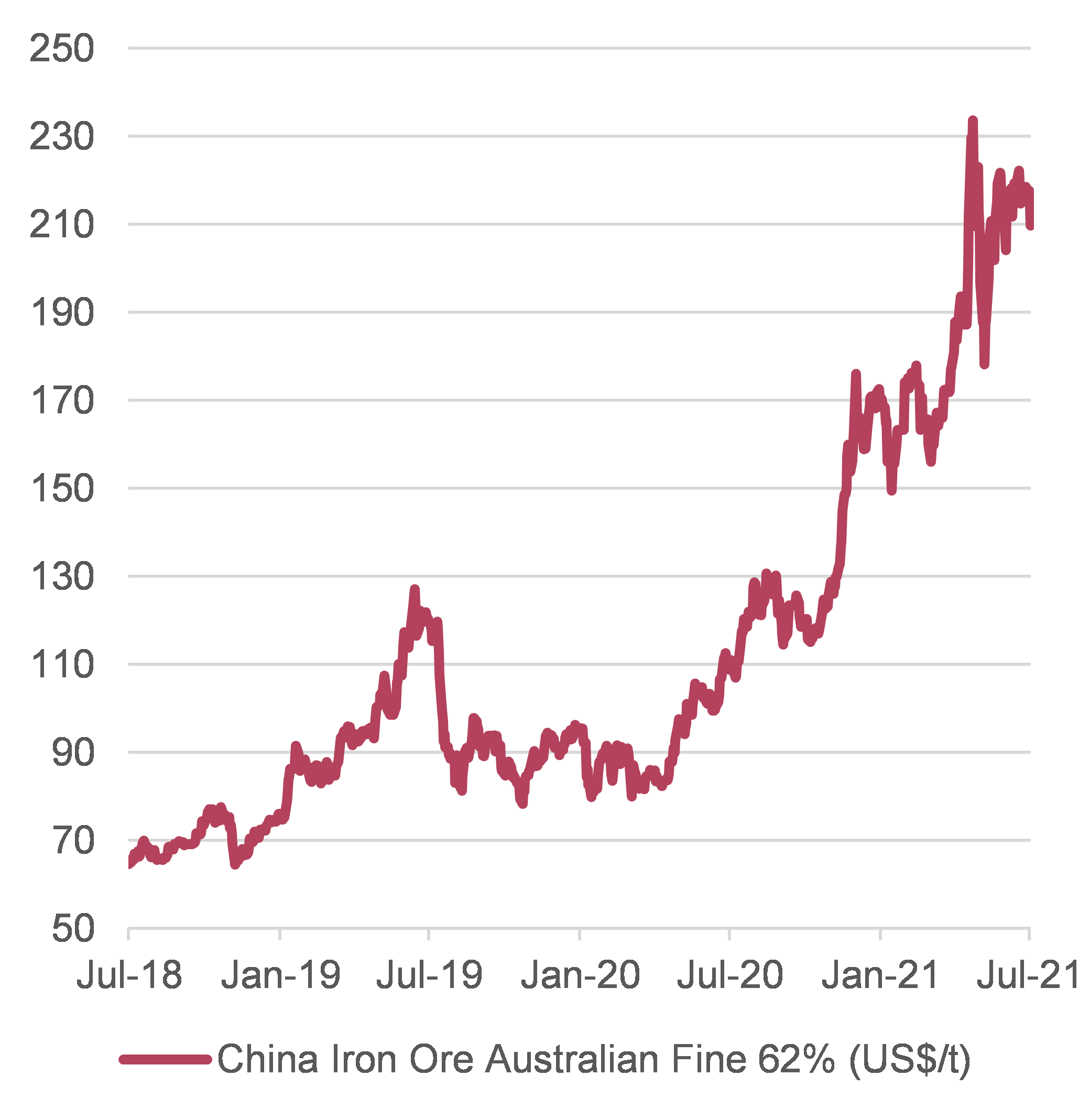
Source: Bloomberg, Morgan Stanley Wealth Management Research. Data as at 21 July 2021.
A longer-term risk (3+ years) we see for iron ore is the rise of EAF utilisation in China. China has the policy to increase EAF in the steel production mix from ~21% in 2020 to 30% over time to reduce steelmaking pollution. Morgan Stanley estimates that achieving 30% would displace ~180MT of annual iron ore demand. What is the potential impact on Australia? Using 2020 figures, China bought approximately 80% of Australia’s production of 855MT. Japan was the second-largest buyer taking around 6% of our production. Australia accounts for about 60% of total Chinese iron ore imports. Assuming our market share of imports is held constant, a 30% EAF production mix would reduce annual demand for Australian iron ore by ~108MT, around double what Japan is currently buying from Australia today.
Morgan Stanley’s Preferred Iron Ore Exposure
Source: Morgan Stanley estimates
Copper
Exhibit 3 – Copper Price
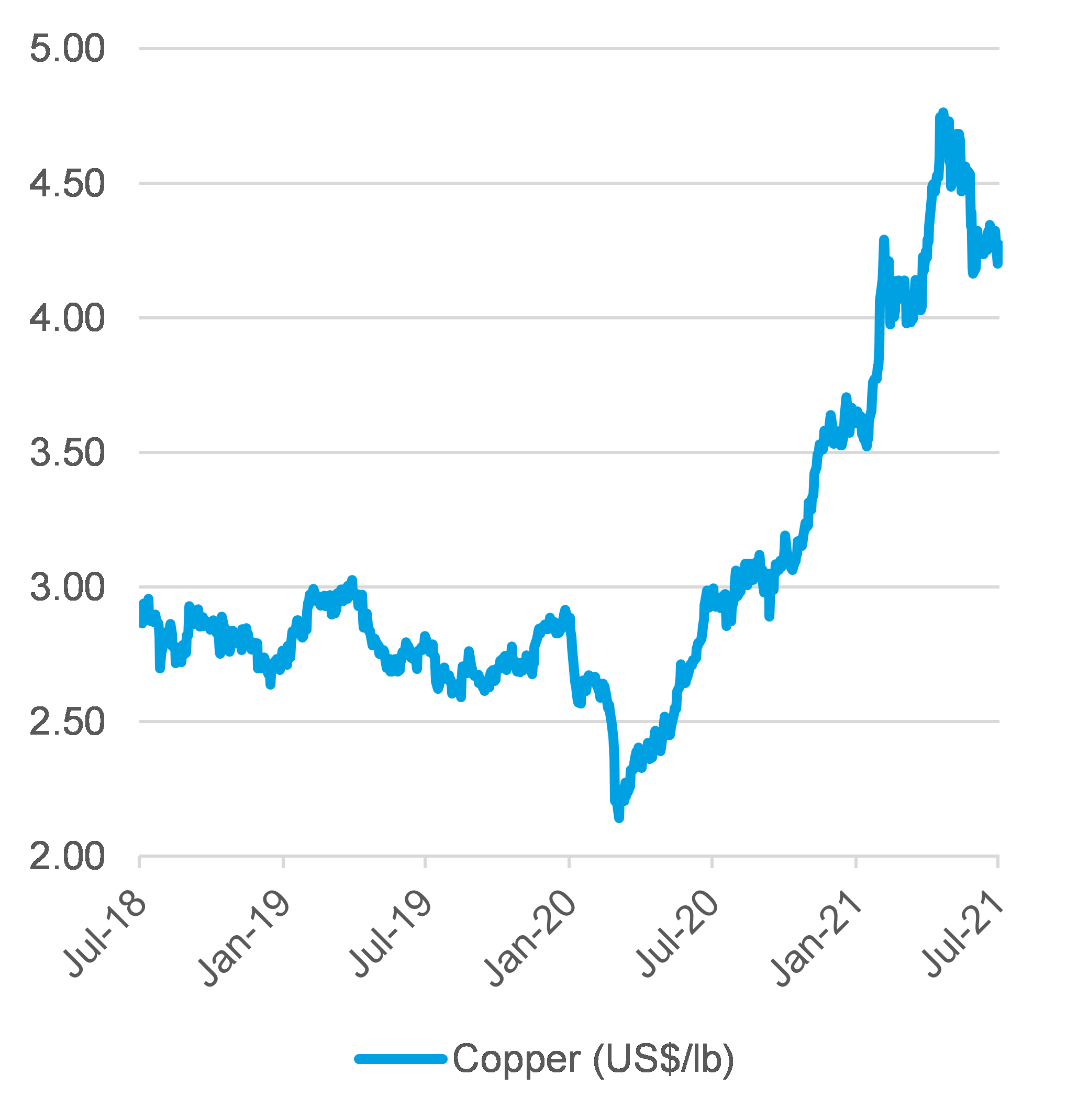
Source: Bloomberg, Morgan Stanley Wealth Management Research. Data as at 21 July 2021.
Following solid Chinese demand in 1H21, Morgan Stanley expects demand to slow in 2H21 as substantive inventories remain in China. We estimate China built up ~1.3MT of copper inventory in 2020 and has only drawn down about 13% so far in 2021. End-use of copper is also entering the seasonally softer summer months within China. Outside of China, demand from the US in particular has been robust as economic activity accelerates as Developed Market economies reopen. Morgan Stanley forecasts flat copper demand from China for 2021 with 8% growth in the rest of the world, bringing global copper demand to 23.6MT. However, new supply should meet this increased demand as Morgan Stanley forecasts over 2MT of production coming to market by 2023. This should take our expected copper supply deficit of approximately 0.2MT in 2021 back into surplus in 2022. While the copper market currently remains in deficit, we are focused on expected grade improvements at several major mines globally and on the labour contract negotiations at Escondida and Codelco as key milestones that production is beginning to rise. Morgan Stanley forecasts copper at US$4.15/lb by 4Q21 and averaging US$3.54/lb in 2022.
Morgan Stanley’s Preferred Copper Exposures
Source: Morgan Stanley estimates
Lithium
Exhibit 4 – Lithium Price
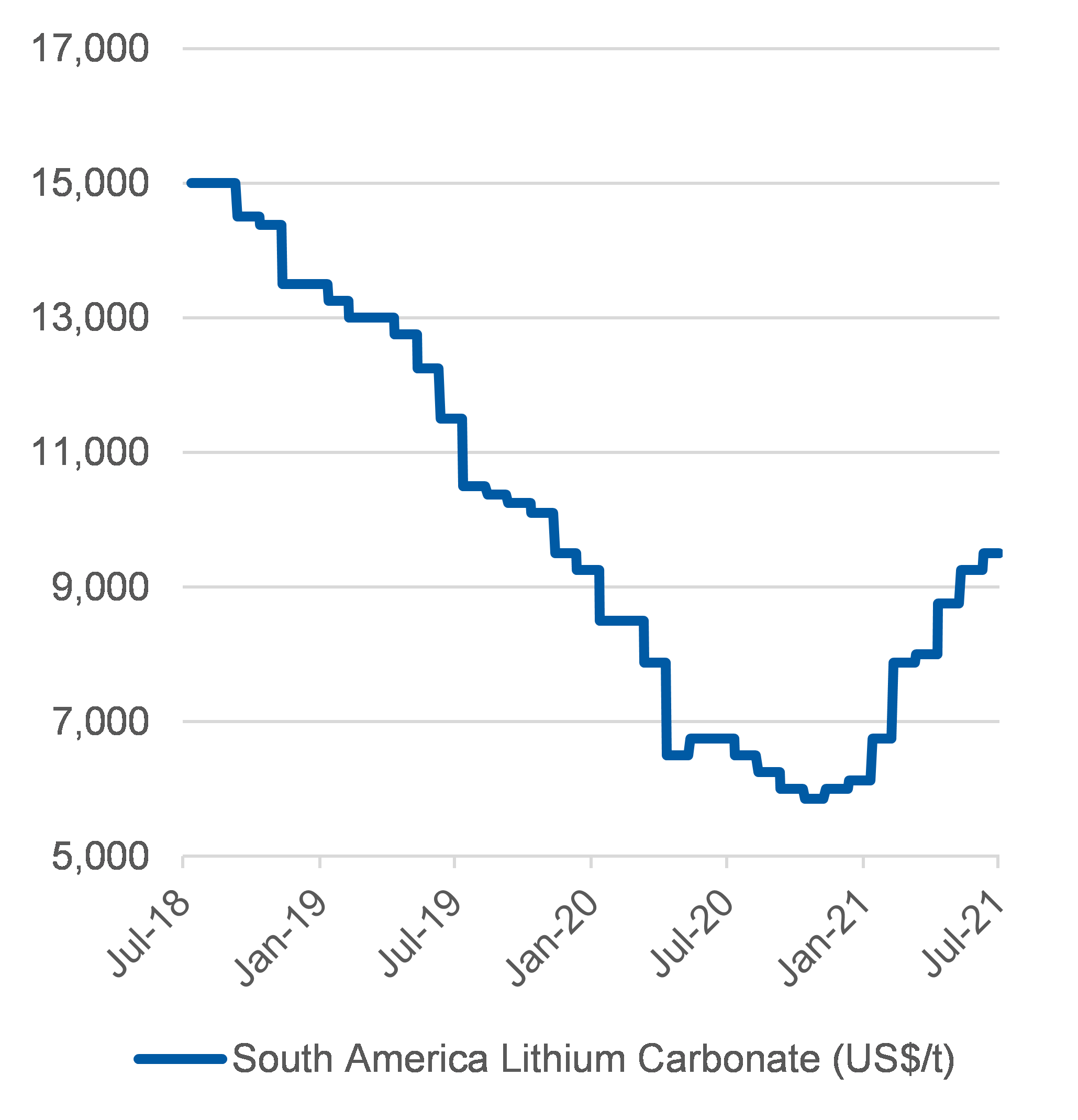
Source: Bloomberg, Morgan Stanley Wealth Management Research. Data as at 21 July 2021.
Feedback from Morgan Stanley’s industry contacts initially suggested a late boom in 2020 for electric vehicles in China and broad-based demand for stationary batteries tightening the lithium market, would drive a rebound in lithium prices this year. However, Morgan Stanley now expects that supply will more than offset surging demand for at least the next several years. In particular China has made significant progress in removing contaminants from brine, allowing more domestic brine sources to be commercially feasible, though at a higher cost than traditional brine projects. Morgan Stanley forecasts lithium carbonate at US$9,500/t by 4Q21 and averaging US$8,438/t in 2022.
Morgan Stanley’s Preferred Lithium Exposure
Source: Morgan Stanley estimates
Uranium
Exhibit 5 – Uranium Price
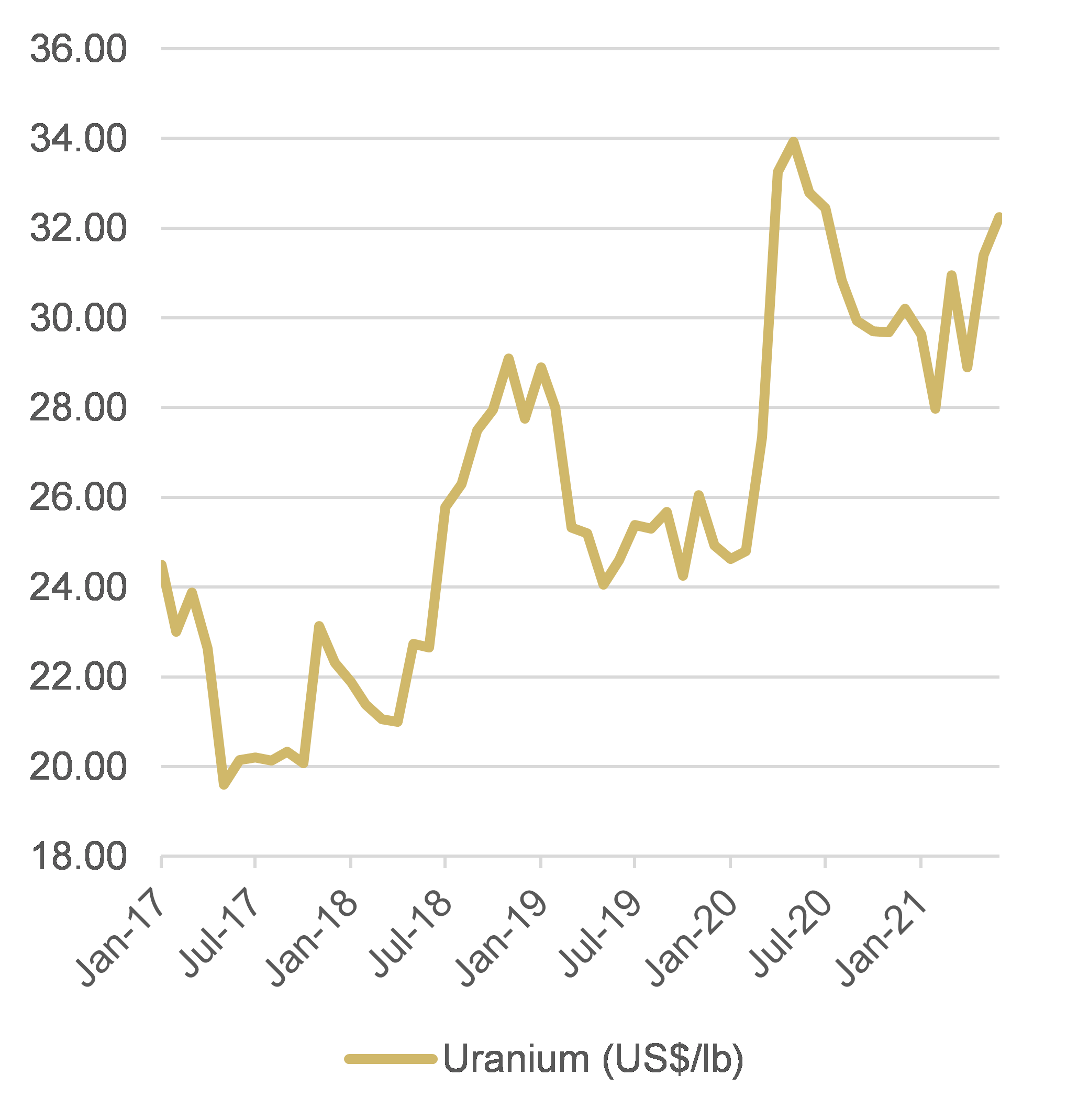
Source: Bloomberg, Morgan Stanley Wealth Management Research. Data as at 30 June 2021.
The uranium market is undersupplied, but inventory consumption and secondary supplies from the enrichment sector have filled the demand gap. We have observed recent strong investment demand from funds and junior miners who seem to be anticipating further tightening in the market. While Morgan Stanley acknowledges supply is returning to the market (for example, Cameco’s Cigar Lake recently raised its production guidance for U308), we believe it will be insufficient to stop further inventory erosion, which should prompt higher U308 prices from here.
Notably, both the EU and US seem to be supportive of nuclear energy on the policy front. The EU Commission has left open the possibility that nuclear power could be labelled a sustainable fuel source to support “other transitional” activities and is expected to decide by 4Q21. Similarly, the Biden administration is rolling out several policies supportive for nuclear as flagged when the US President initially announced the proposed US$2 trillion American Jobs Plan. Morgan Stanley forecasts U308 at US$33/lb by 4Q21 and averaging US$35.50/lb in 2022.
Stocks Under Morgan Stanley’s Coverage With Uranium Exposure
Source: Morgan Stanley estimates. Note: BHP exposure is through Olympic Dam which represents <1% of group revenues. RIO’s exposure is through Ranger which represents ~1% of group revenues.
Nickel
Exhibit 6 – Nickel Price
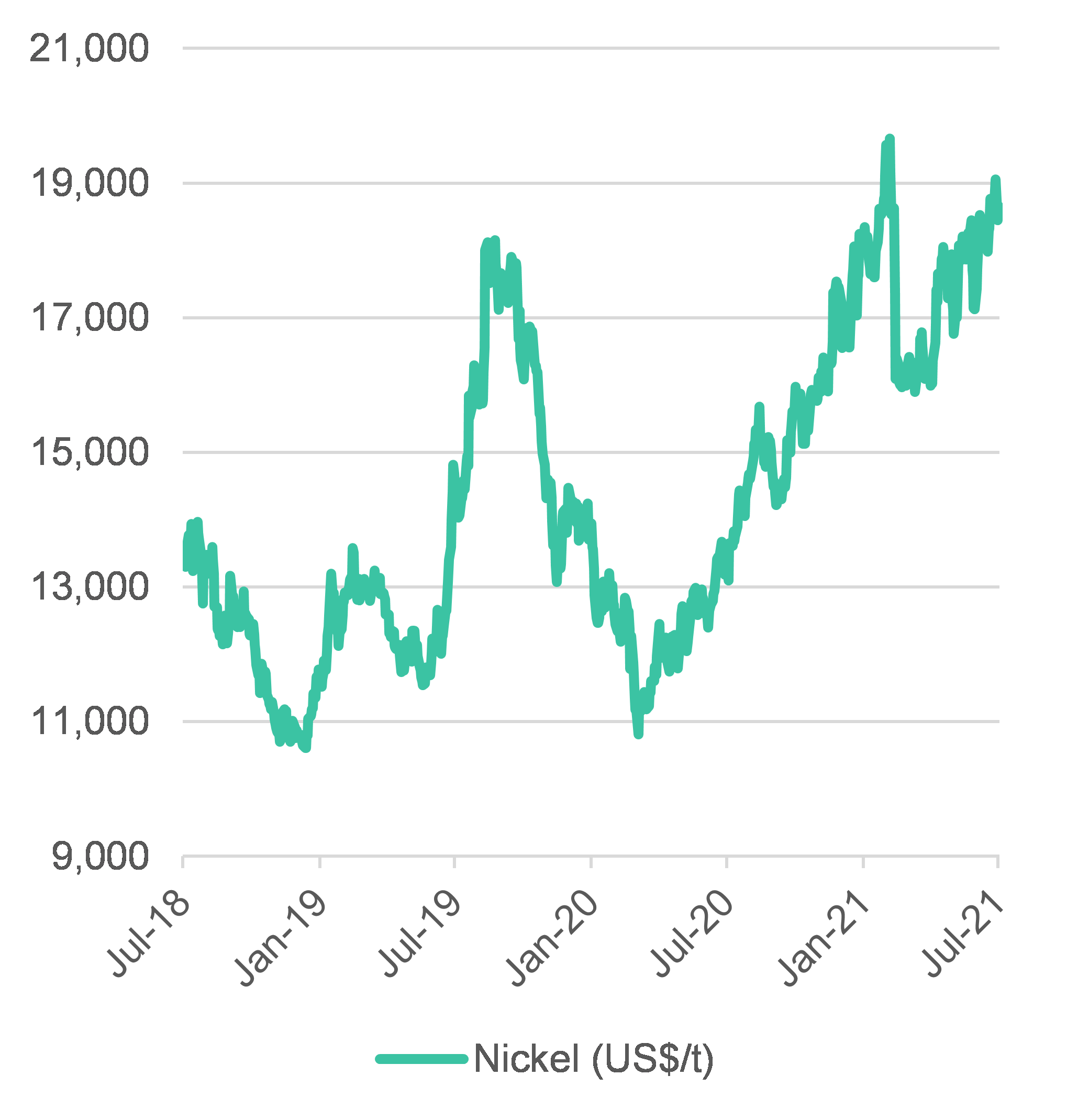
Source: Bloomberg, Morgan Stanley Wealth Management Research. Data as at 21 July 2021.
The nickel market moved back into deficit through 2Q21 following the strong US and European stainless steel demand. The flooding and concentrator outage at Norilsk also contributed to tight supplies supporting the recent rebound in Nickel prices. Near term, Morgan Stanley sees the risk of a potential Chinese export tax on stainless steel that could trigger lower stainless steel prices and potential destocking. This selling and recovering in supplies are likely to put downward pressure on nickel prices for the balance of 2021. Morgan Stanley forecasts nickel at US$16,314/t by 4Q21 and averaging US$15,074/t in 2022.
The announcement earlier this year from Tsingshan that from October 2021, it will begin to produce 75,000 tpa of nickel-in-matte from saprolite ore in Indonesia for conversion into sulphate to feed the electric vehicle market could be a significant change for nickel supply into the battery market. It is widely expected that the growth in electric vehicles and battery demand, in general, will lead to material deficits in the nickel market in the medium term. On Morgan Stanley’s estimates, we anticipate this shortfall to begin in 2025. A new nickel source would help alleviate these concerns; however, Tsingshan’s pyrometallurgical process can produce up to 10x more carbon than the current hydrometallurgical process. A highly carbon-intensive process is likely unacceptable for automakers in the US and Europe under pressure to reduce the carbon footprint from electric vehicles.
Morgan Stanley’s Preferred Nickel Exposure
Source: Morgan Stanley estimates.
Aluminum
Exhibit 7 - Aluminum Price
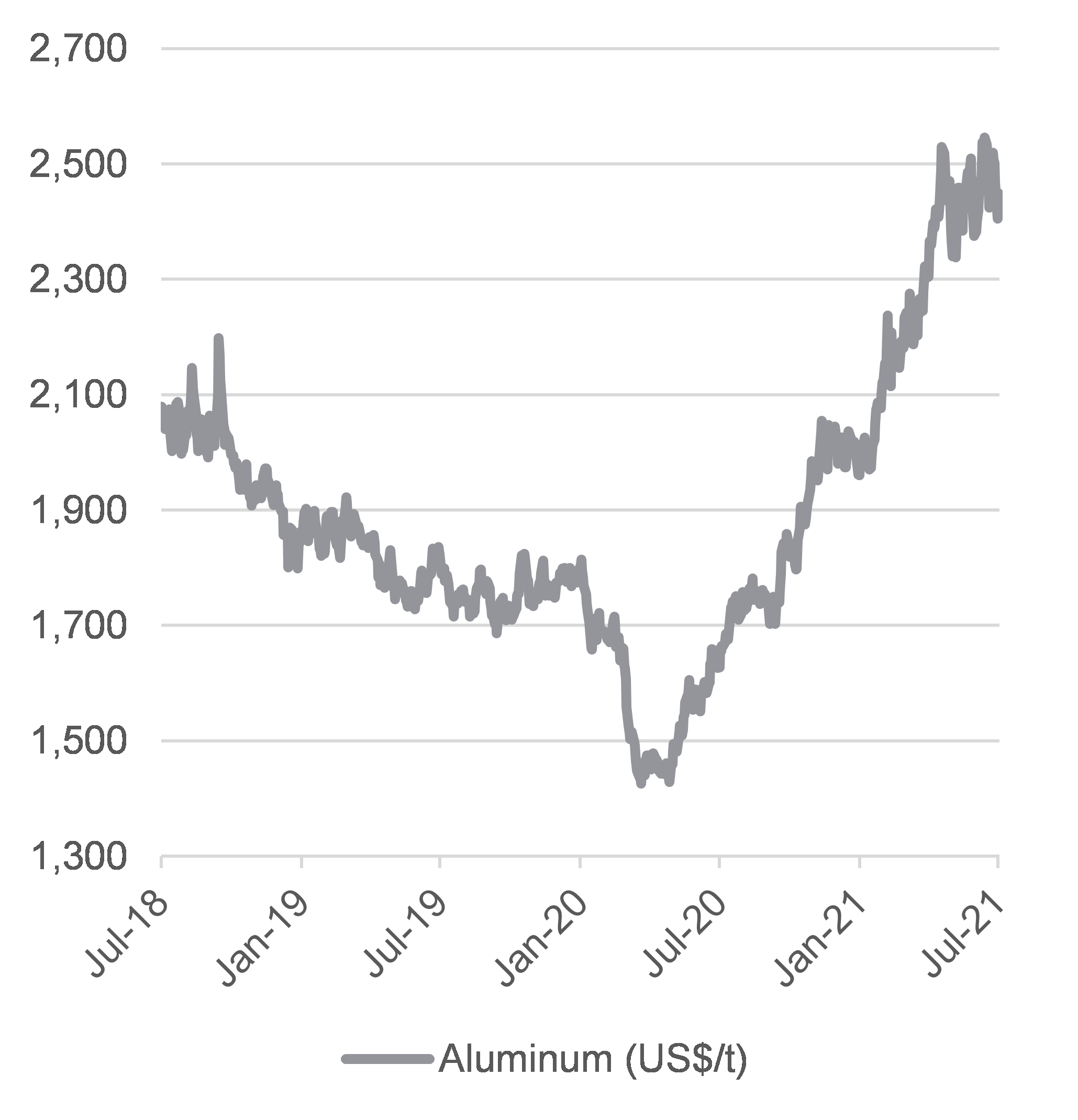
Source: Bloomberg, Morgan Stanley Wealth Management Research. Data as at 21 July 2021.
Aluminum prices reached new highs in 2Q21 on strong demand from the automotive, packaging, construction and consumer goods sectors. Simultaneously, supply was constrained by high freight rates, tightly held inventory, limited scrap availability and anti-dumping measures in Europe and the US restricting imports. China’s persistent aluminum imports are the result of ongoing power shortages and environmental policies limiting power consumption. This cascades down to aluminum smelters which are very energy-intensive industries, capping their ability to respond to the strong demand inside China. Europe and the US are equally supply constrained in the face of strong local demand. Morgan Stanley currently forecasts aluminum at US$2,337/t by 4Q21 and averaging US$2,183/t in 2022. However, the recent announcement of a 15% Russian export tax could push prices higher and ongoing power constraints in China suggest upside risk since Morgan Stanley published this price forecast back in June.
Morgan Stanley’s Preferred Aluminum Exposure
Source: Morgan Stanley estimates.
Alumina
Exhibit 8 – Alumina Price
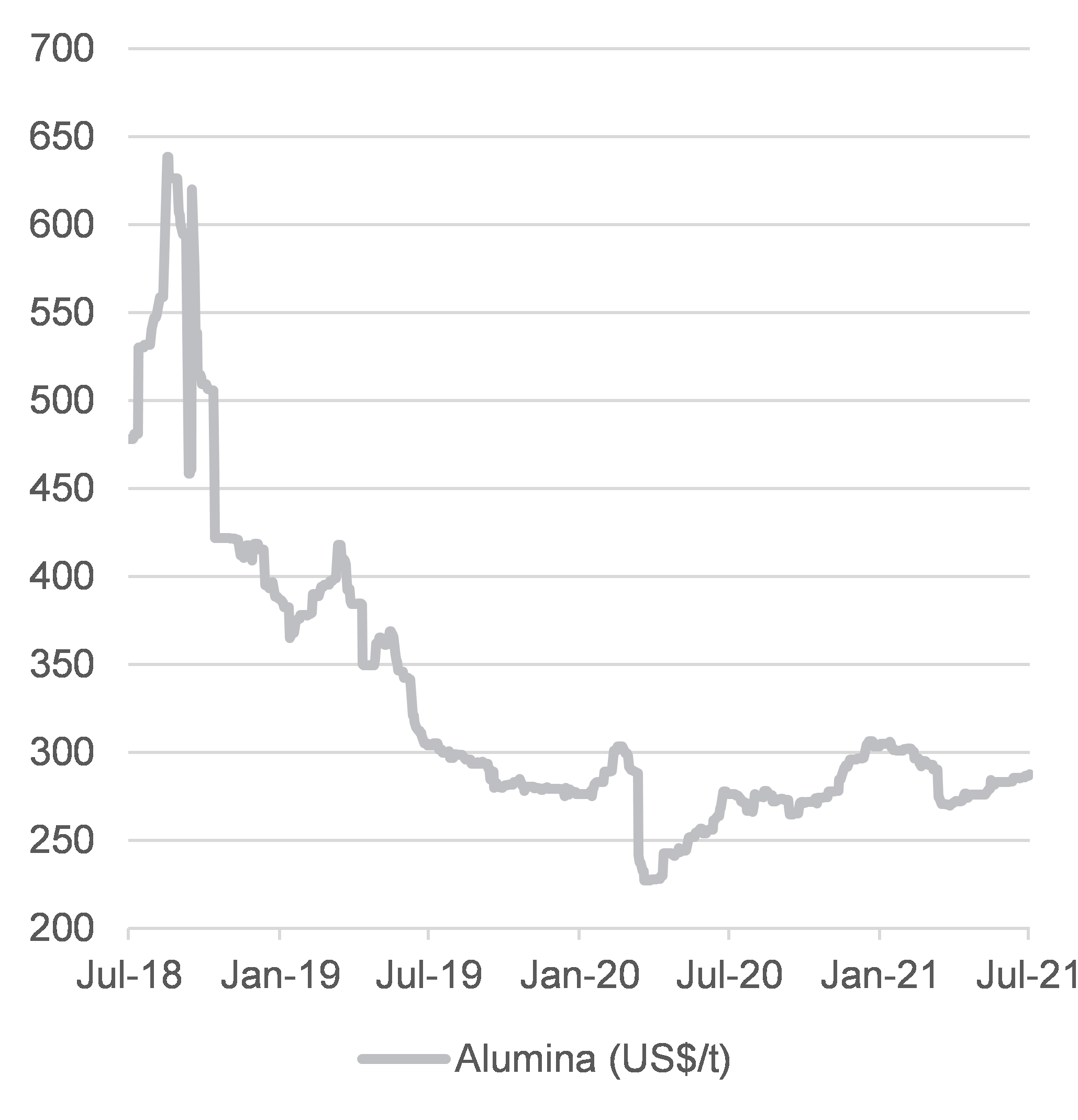
Source: Bloomberg, Morgan Stanley Wealth Management Research. Data as at 21 July 2021.
Near term, high shipping rates have been counter intuitively, impacting alumina prices as it has become too expensive to import Australian alumina. Morgan Stanley assumes freight rates will soften over the remainder of the year and some Chinese smelting capacity should resume which together will likely support alumina prices for the balance of 2021.
However, a growing global market surplus is expected to worsen if China continues to restrict growth in its smelting industry while allowing alumina capacity to expand. Morgan Stanley forecasts alumina at US$298/t by 4Q21 and averaging US$289/t in 2022.
Morgan Stanley’s Preferred Alumina Exposure
Source: Morgan Stanley estimates.
Please click 'Contact' if you would like a copy of the full Morgan Stanley report.
4 topics

